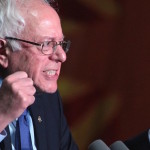WHAT’S IN A NAME
Do some of you remember the clever Cole Porter lyrics “You say potayto and I say Potahto, you say tomayto and I say tomahto” ?
They illustrate the unimportant ways that people use to take separate paths no matter how much they want to get along; politics and politicians do this all the time.



Developing a stump speech focusing on the enormous power and privilege of millionaires and billionaires who were able to buy politicians and favorable policies, Sanders was stunned by the immediate impact he made on America’s newest population sector: the millennials. Out of college, broken by student debt, finding a shallow job market, living at home, failing to begin a life once promised them by a middle class which had shrunken into invisibility, not known as voters, millennials fell in love with Bernie. They didn’t quite understand the democratic socialist stuff but they certainly felt comfortable with ‘progressive’,
His views, many of which sounded like speeches from labor union leaders made generations ago, were clearly about liberalism lost and the need to restore it.
But he did not refer to himself as a liberal. What we were hearing and cheering were his views as a progressive. While the media referred to them as liberal, Sanders and a large number of prominent Democrats had scrapped liberal under the influence of the rabid Karl Rove and his successful attempts over years to paint every liberal aspect of America as bad. They hid behind the label ‘progressive’.
Their platform is essentially simple: stop the millionaires and billionaires from taking over America by forcing them to pay taxes more commensurate with a fair distribution of wealth. Scrap all healthcare as we know it and accept a single payer government form called Medicare for All. Deal with the enormous $1.3 trillion of college debt by making all public universities free.
There are other aspects but the foundation of this progressive approach is to tax the rich to make everything else possible and to severely limit their influence.
.And yet, then and now there was never an answer from any ‘progressive’ about how all of this would take place. There was never a mechanism developed to make these changes possible and real. The idea is to make things good again but there is no plan to make these ideas work.
The challenges are stunning. Single payer (government) healthcare when the most powerful corporate influence in Washington is the healthcare insurance industry? Tax the millionaires and billionaires enough to pay for these new programs when they clearly own those voting on such a tax increase? Make public universities free but do nothing about the millions owing $1.3 trillion? And what would the annual cost of such free tuition be – year after year after year? And all of this on the backs of taxpayers?
Questions but no answers.
IN NEW YORK

Admitting corruption, as elected leaders are marched off to jail and people very close to the leader are convicted of graft and bribes, the charade of ‘good government’ continues. Democratic politicians deal with it in a number of creative ways.

Recently there seems to be a new group who have been duped but are seeing the light. This includes the surprise winner of a Congressional primary where a neophyte Alexandria Ocasio-Cortez easily defeated 20 year office holder Crowley.

She won.
But the election for the Congressional seat is in November and Crowley has a place on the ballot.
Much has been made of the labels democratic socialist and progressive. They are labels. They are not policies that work. The labels are on politicians – including progressive Mayor Bill DeBlasio who has not made anything work.
Can a national party produce a victory when its leading affiliate in New York is so corrupt for so many years?
Can a real estate developer continue to practice his own charades as successfully as he has working from his belief that the public is so sick of the lies of professional politicians that they will continue to buy his own brand?
Clues to the answers to these questions might come from the results of the November Congressional elections.
What is increasingly evident is that labels Democrat and Republican are washing away with continued abuse and stand for little or nothing. As long as people in politics see their continued election as their only real purpose, those labels will be worthless and any new ones probably won’t have the sticking power to stay around.
But it’s not new labels that we need. It’s a new belief in the once powerful ways of American democracy.
Click on the title below to view a list of political parties known throughout our history. Many hundreds exist. These are among the most interesting.
